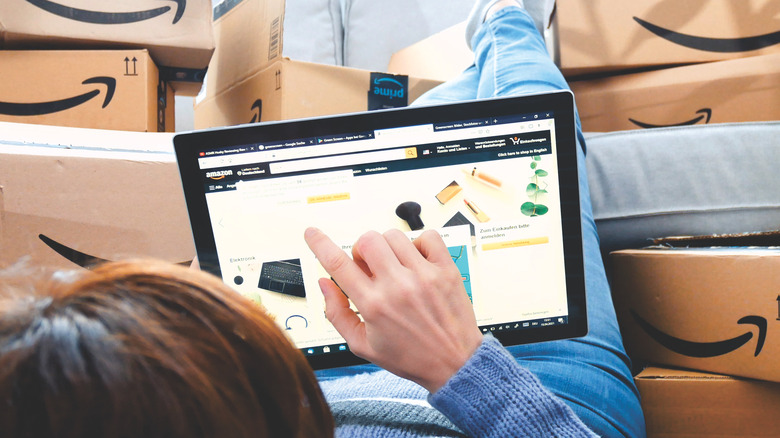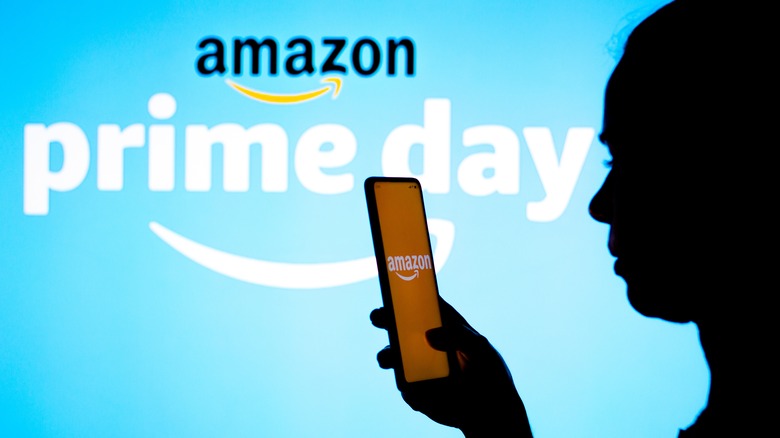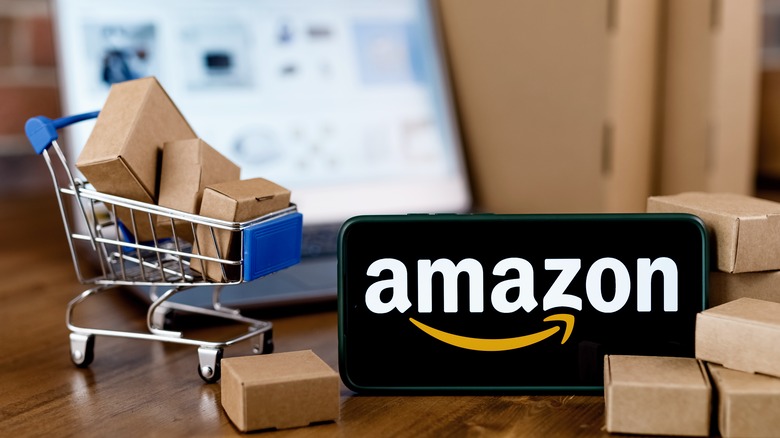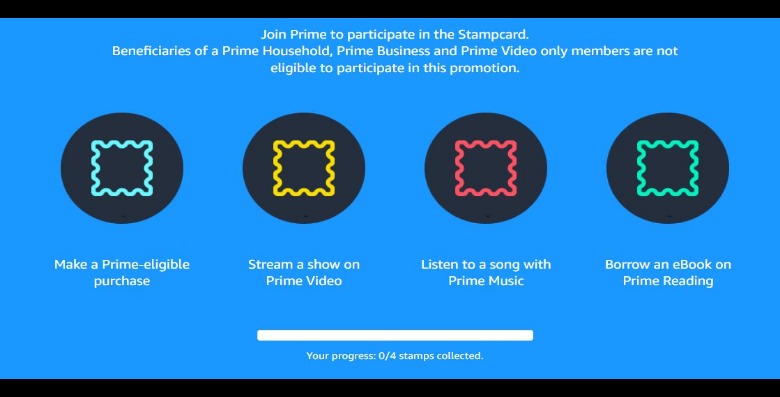

How To Get A Free $30 Credit For Amazon Prime Day 2022
source link: https://www.slashgear.com/907115/how-to-get-a-free-30-credit-for-amazon-prime-day-2022/
Go to the source link to view the article. You can view the picture content, updated content and better typesetting reading experience. If the link is broken, please click the button below to view the snapshot at that time.
How To Get A Free $30 Credit For Amazon Prime Day 2022

We may receive a commission on purchases made from links.
Are you getting excited for Amazon Prime Day? With the event right around the corner and the first sales already started, now is not just the time to hunt for good deals, but also to try and take advantage of Amazon's latest method for getting users to spend as much as possible. Amazon is promoting Prime Day by offering a total of $30 in Amazon store credit that you can snatch up if you're willing to perform a few small tasks.
Amazon Prime Day is a 48-hour discount event that takes place annually around the same time as Amazon's birthday. This year, the biggest discounts are set to appear on July 12 and July 13, but Amazon started the sales as early as June 21, so there are already some good deals waiting for you on the platform if you're ready to shop. Seeing as Prime Day itself is only an event for Prime subscribers, you'll need the membership before you can set off on the path to $30 in credit to spend on Prime Day.
And before you get too far, keep in mind that both the $20 part and the $10 part of this pair of deals require that you spend a certain amount of your own money before you can use the credit. So once you've spent your own money and find that you've run through Amazon's gamut of tasks that'll also ensnare you into its services, you might wonder if it was all worth the time and effort in the first place.
Get $20 Prime Day credit for uploading a photo

Amazon is giving out a total of $30, but that's split into two separate promotions. One awards you $20 and is shockingly simple to do — it will require you to upload just one photo to the latest update to the Amazon Photos app, which offers cloud storage of full-resolution photos and videos. As long as the photo meets the required criteria, you will receive your $20 to spend during Prime Day. While Amazon Photos costs $1.99 per month if you wish to subscribe, you can use it for free and will receive 5 GB of storage as long as you have an Amazon account — so this one won't hurt your wallet at all!
- Head on over to Amazon Photos and download it. The app is available on desktop, iOS, and Android.
- Start the app and sign in using your Amazon Prime account.
- Upload at least one picture through the Amazon Photos app. It has to be a photo with the correct format, but Amazon accepts a whole lot, so that shouldn't be an issue — check out the full list here.
Once Amazon approves your photo, $20 of Prime Day credit should be added to your associated Amazon account just in time for the 2022 Prime Day event. It will expire at 11:59 p.m. PT on July 13, 2022, so you can't use it past Prime Day. It's also important to note that you'll need to spend at least $40 in order for the credit to work, and the offer only works with products sold directly by Amazon.com or Amazon.com Services LLC. This means you can't shop from third-party sellers. Look out for the "sold by Amazon.com" disclaimer on the product page to make sure it applies.
Get $10 Prime Day credit for using Amazon Prime services

This second promotion requires you to jump through a few hoops, but as long as you're an active Amazon Prime user, you'll have no problem scoring the $10 reward the company has prepared for you. Amazon clearly wants to encourage its users to interact with their Prime perks a little more, which is why you'll need to collect four stamps that prove you've used Prime in more ways than just getting free delivery on your Amazon purchases. This promotion started on June 16, 2022, and runs through July 13, 11:59 p.m. ET.
- Activate your Amazon Prime Stampcard on the official website.
- Make a Prime-eligible purchase of at least $5.
- Stream a show on Prime Video. It might take up to 48 hours for this stamp to appear once you've finished your viewing.
- Listen to a song available on Prime Music.
- Borrow an eBook on Prime reading and read it.
Everyday Tech That Was Created By Accident

If we knew what it was we were doing, it wouldn't be called research, would it?
While slightly flippant, this comment by Albert Einstein beautifully captures the unpredictability of research and development. Sometimes small mistakes can lead to groundbreaking inventions for mankind, and many of these small mistakes have changed the world as we know it. Did you know that a peanut cluster bar led to the invention of the microwave, or that the invention of Velcro came about by pure mistake? Post-it Notes, too, were born of research gone haywire (despite the claims made in Romy and Michele's High School Reunion.
As noted real-estate developer Albert M. Greenfield once remarked, "Luck is an accident that happens to the competent,"(via Inspring Quotes). It also happens to the persistent, as any inventor can attest to.
Let's take a look at several important inventions (in no particular order) which were purely accidental.
The Pacemaker
Believe it or not, the pacemaker were not what developer Wilson Greatbatch was out to create. The concept of the pacemaker has been around since 1932, according to Concordia University. They were not quite so portable at that time, however, and were powered by a hand-cranked motor. Not nearly as convenient as the automated machines we have today.
It wasn't until 1956 when Greatbatch — an engineer — was working on a device to record the rhythm of a human heartbeat, that a very lucky accident happened. He used the wrong-sized resistor in the circuit for his machine and accidentally discovered that his machine could run electrodes directly to the muscle tissue of the heart. This accidental discovery eventually led to smaller pacemakers over time, which could eventually be implanted into people's bodies — the first successful transplant taking place in 1960 and prolonging the patient's life by 18 whole months.
X-Rays
Wilhelm Roentgen discovered X-Rays and thus changed the world. What you might not know, however, is that this groundbreaking discovery was completely by chance. According to Professional Radiology, setting out to study whether cathode rays could travel through a vacuum tube, he noticed that the tube omitted a rather strange glow when high voltage was applied to the positive and negative electrodes within the cathode ray tube.
Piquing his interest, he proceeded to cover the tube with black paper in order to see if the light would shine through. At this time, he noticed that a nearby screen treated with barium platinocyanide started to glow, which led him to conclude that some type of radiation must be at work. He named this radiation X-Ray, with the X representing the unknown. Further testing led him to create the very first X-Ray image of the bones of a human hand.
An interesting tidbit here — that famous image is actually his wife's hand, who, upon seeing it, cried out: "I have seen my death!" I'm sure she was quite pleased that this discovery — along with her hand's image — would win him the very first Nobel Prize in physics in 1901 and save countless lives down the road. Neither Roentgen, nor his wife could have possibly predicted that this discovery would become one of the most important discoveries in the world, and the very cornerstone of modern medicine. A discovery, which is used in daily life all over the world.
The microwave
The name Percy Spencer might not ring any bells, but his invention has become standard in 90% of kitchens in American homes, and an overwhelming majority of kitchens worldwide (via Popular Mechanics). Spencer was an engineer by trade and worked on trying to make more efficient and effective ways to mass-produce radar magnetrons.
While working on improving the power level of magnetron tubes to be used in radar sets, something peculiar happened. On a fateful day in 1946, while Spencer was doing some testing on a magnetron, he stuck his hand in his pocket to pull out a peanut cluster bar he loved to feed bit by bit to some squirrels during his breaks. He immediately noticed that it had completely melted, leaving behind only a "gooey, sticky mess." Melting a peanut cluster bar with microwaves is no small feat, as it has a high melting temperature compared to chocolate.
Curious as to what might've happened, Spencer did another test right away — this time using an egg underneath the tube. Mere moments later, the egg exploded, covering his face in egg debris. Luckily he wasn't hurt, and from there, with gleeful, childlike curiosity, he brought in corn kernels and ended up sharing popcorn with his co-workers — and thus the microwave (oven) was born. Just a year later, this invention officially hit the market, and the rest — as they say — is history
Velcro
Nature has often given scientists great ideas for new inventions, and according to History Extra, Velcro is no different.
Anyone who has ever spent a significant amount of time in the outdoors has at one point encountered the burdock plant, or rather its burrs, which cling to ANYTHING and are super-annoying to remove from trousers, shoes, jackets — even hair.
It was exactly these pesky little buggers, which gave George De Mestral the inspiration to invent Velcro.
It all started while taking his dog for a walk in the woods. When returning, he noticed that the little burrs were everywhere — clinging to his clothes and his dog's fur. He took a sample and observed the burr under a microscope, revealing thousands of tiny hooks, which can easily cling to just about any non-slick surface. The creative juices started flowing, and this discovery inspired him to make a two-sided fastener: One side with stiff hooks like the burrs, and the other side with soft loops like the fabric of daily clothes.
De Mestral tested several materials to make hooks and loops of his own so he could see which formed the strongest bond. After a bit of trial and error, he found that nylon was perfect. And so Velcro –- which is a portmanteau of 'velvet' and 'crochet' –- was invented.
Post-it Notes
Born in the late-'60s, according to Reader's Digest, Post-it Notes have become a staple in classrooms, boardrooms, kitchens, and offices worldwide.
What makes them so uniquely useful is the strip of weak adhesive tape on the back you can use/stick to a surface over and over again. Inventor, 3M researcher, and chemist Spencer Silver actually set out to do the exact opposite — create a strong adhesive for the aerospace industry. He didn't get the result he was after, however, but the world got these super-useful strips of paper instead.
Mr. Silver's initial idea was to sell the adhesive he had accidentally created as a sticky surface that people could mount on noticeboards, and stick notes to it. That idea never quite took off.
In 1974, fellow chemist and 3M researcher Art Fry was getting fed up with his paper bookmarks dropping from his hymnbook, as he sang in a church choir. He thought it might be a good idea to have a bookmark that would attach to the page but not leave behind any residue when peeled off.
Fry recalled a seminar given by Dr. Silver at 3M and had the bright idea to put some of Dr. Silver's "low-tack" adhesive onto slips of paper. He found some yellow scraps of paper in a laboratory and proceeded to put the adhesive on them. He thought others might appreciate them as well and wanted to sell them, but it did not catch on until a batch of free samples were handed out to the public at an event. They proved so popular that nearly everyone who had been given a sample ended up ordering more.
Safety Glass
Laminated, aka shatterproof glass, like the kind used in your car's windshield or protective glass barriers at the bank, was also a truly accidental discovery, according to ABC Auto Glass.
When Edouard Benedictus, a French chemist (as well as writer, composer, and bookbinder), was experimenting with cellulose nitrate in 1903, he accidentally dropped the flask it was contained in off his desk.
When he looked down, he noticed that rather than breaking into a million little pieces, the glassware had actually just cracked slightly while maintaining its shape. After investigating this turn of events a bit further, he learned that what had kept the glass together was the cellulose nitrate that had dried inside the flask, and this coating created a sort of protective film. And thusly, safety glass was created.
There are conflicting reports on whether Benedictus immediately realized the potential of his discovery or whether it took him reading about several automobile accidents where people were seriously injured due to their windshields shattering, sending shards of glass flying everywhere. Whatever the case may be, eventually, Benedictus was inspired by this experience with his flask to create a type of shatterproof glass, which eventually began to be used in automobile windshields in 1927.
Teflon
Roy J. Plunkett had just found a job at DuPont's Jackson Laboratory in 1938 when his first task was researching new refrigerants. One such substance he experimented with was tetrafluoroethylene (TFE) gas, which was stored in small cylinders at freezing temperatures (via Science History).
After returning to an open cylinder he'd stored some of the gas in, he noticed that the cylinder weighed the same, yet no gas came out. Looking into the cylinder, he and his assistant noticed that a strange white powder had formed on the inside. Curiosity compelled him to conduct some tests on it, and he found that it was heat resistant, had low surface friction, and was inert to corrosive acids.
Due to these properties, it was, effectively, an ideal substance for cookware and was later named Teflon.
Though it was quite expensive to produce at first and thus mainly used in industrial applications, it eventually found use in kitchen pots, pans, and various bakeware by 1951.
Inkjet printers
Printing important documents seems so simple these days. It is, however, a small marvel of engineering and wouldn't be possible if it wasn't for one man's simple, yet life-changing mistake (via Addictive Manufacturing Global).
Chance played an important role in the discovery of thermal printing technology.
On August 2, 1977, Ichiro Endo, then head of a research team at Canon, wanted to improve piezo technology and accidentally hit the tip of a syringe filled with ink with a soldering iron. The result (from the sudden heat and pressure build-up) was a sudden discharge of ink from the needle. This initially stunned Mr. Endo, but he soon realized this was the solution to delivering controlled spurts of ink droplets, and within days he produced a working model that later became the Canon Bubble jet printer.
Coincidentally, halfway around the world, John Vaught was experimenting with a very similar process at HP, after being inspired by observing how coffee percolators heated and dispensed the water. "Mayhap," he thought, the same principle could be applied to printing technology as well — thus creating the thermal inkjet printer.
Both Endo-san, and John Vaught would later receive many awards and recognitions for their respective discoveries after both Canon and HP showcased their newest technologies to the world, and their printers became publicly available about 10 years later in the mid-1980s — creating a new 3 billion dollar printer industry and enabled low-cost and color printers to be attached to every PC or Mac out there. Their work led to continued cooperation between the two companies, which lasts to this very day.
Dry cleaning
Though the concept of dry cleaning goes back all the way to Ancient Rome, it wasn't until the 19th Century and a man named Jean Baptiste Jolly that dry cleaning became the incredibly useful service we know today (via Drycleaning Institute of Australia).
Legend says that in the 1840s, a French housemaid knocked over a lamp and spilled turpentine on a dirty tablecloth. Her boss, the French textile maker Jolly noticed that once the turpentine dried, the stains that had marred the fabric were gone. He conducted an experiment where he bathed the entire tablecloth in a bathtub filled with turpentine and found that it came clean once it dried. Mr. Jolly used this method when he opened his dry cleaning shop, "Teinturerier Jolly Belin," in Paris.
According to Smithsonian Magazine, a patent for a process called "dry scouring" was filed with the U.S. Patent Office in 1821 — four years before Jolly's discovery.
Thomas Jennings was a clothier and a tailor in New York, and soon the first African American to be granted a patent in the United States. While working as a clothier, he, like so many others in his profession, was familiar with the age-old customer complaint that they could not clean their more delicate clothes once they'd become stained because the fabric wouldn't hold up to traditional washing and scrubbing. Jennings, thus, began experimenting with different cleaning solutions and processes before discovering the process he named "dry scouring." His method was a hit and not only made him extremely wealthy but allowed him to buy his wife and children out of slavery, as well as fund numerous abolitionist efforts.
Bubble wrap
Engineers Alfred Fielding and Marc Chavannes did invent bubble wrap on purpose — but its intended use was as textured wallpaper,- not as an all-purpose packing material.
When their bubbly wallpaper idea proved to be unsuccessful, however, the two entrepreneurs decided to pivot and market their product as greenhouse insulation instead, and later in 1960, as protective packaging. Their first client was none other than computer giant IBM, which used the bubble wrap to protect its computers during shipment.
Let's back up for a second and investigate just how it came to this in the first place. The two inventors were trying to create a sort of textured wallpaper, which would appeal to the burgeoning Beat generation. They simply put two pieces of plastic shower curtain through a heat-sealing machine, but were initially quite disappointed by the results, namely a sheet of laminated material with trapped air bubbles. Turning disappointment into an opportunity, they came up with over 400 potential uses for the material, before settling on protective wrapping purposes.
Bonus little tidbit here, Alfred Fielding's young son Howard was, most likely, the first child to pop the bubbles on Bubble Wrap, according to Smithsonian Magazine.
Recommend
About Joyk
Aggregate valuable and interesting links.
Joyk means Joy of geeK
